Chinese Chayote Dumplings, more commonly known as boulette chouchou or niouk yen (by the Chinese community), are one of our most popular Mauritian street foods. Boulette chouchou is a Mauritian classic that you can find at almost every street corner on the island. It’s served with hot sauce and both with or without broth.
Chinese chayote dumplings= boulette chouchou = niouk yen
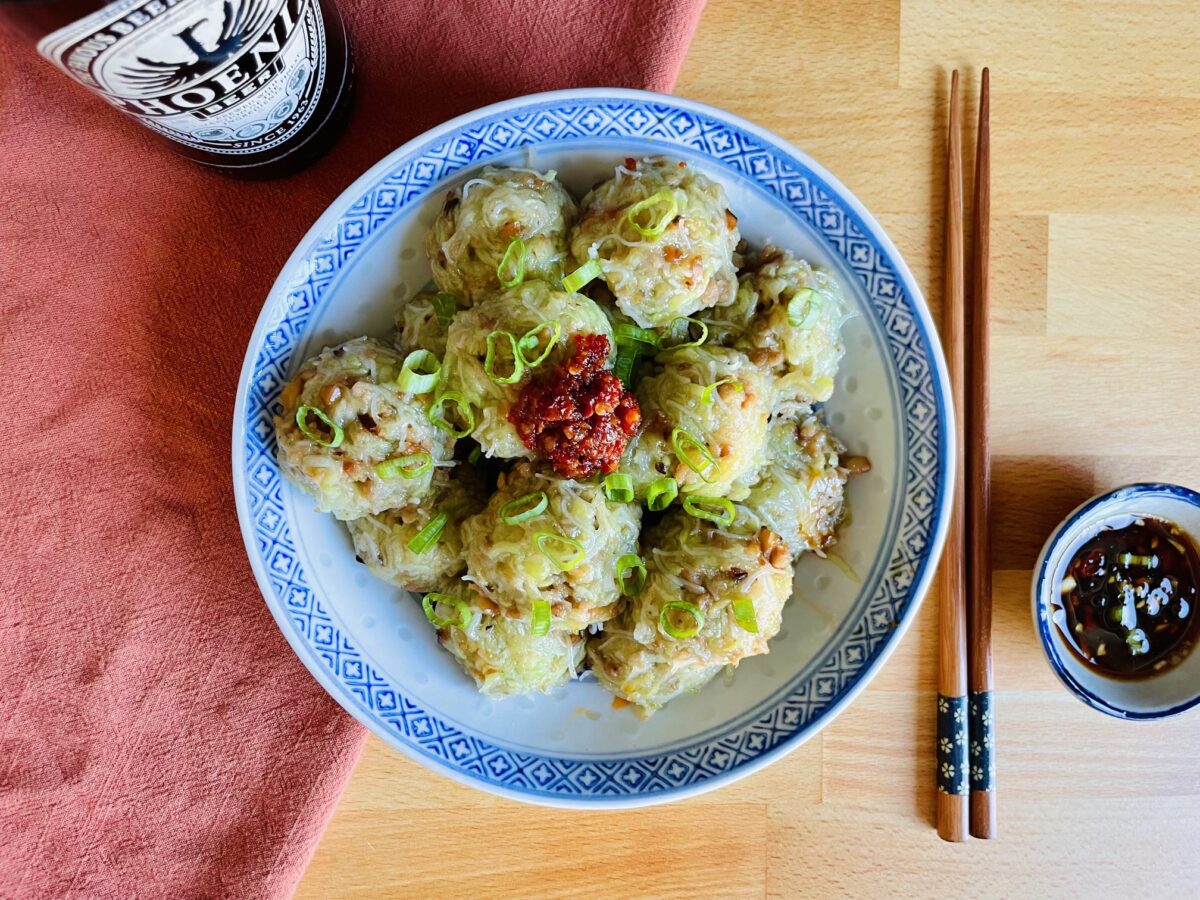
Jump to:
- What is chayote squash
- Common culinary uses for chayote
- What are Chinese chayote dumplings (niouk yen)
- What does boulette chouchou taste like
- Its journey to Mauritius
- My version of Chinese chayote squash dumplings
- Why you’ll love this niouk yen recipe
- Recipe ingredients
- Ingredients notes
- How to make this Chinese chayote dumplings recipe step by step
- How to prepare the chayote
- Sourcing chayote squash for Boulette Chouchou
- Storage and freezing
- Frequently Asked Questions (FAQs)
- What should I serve with Mauritian boulette chouchou
- Chinese Chayote Squash Dumplings Recipe (Boulette Chouchou)
What is chayote squash
Despite its widespread use across China and India, and its popularity in Mauritius, chayote squash is still one of the lesser known squash in the West.
Native to Mexico, chayote is a thin-skinned squash and a member of the gourd family. The most popular variety is the light green skin one with white flesh.
This almost pear-shaped bumpy produce is extremely versatile due to its mild taste and crunchy texture. It can be used raw in salads, stir-fries and, as is the case of this recipe, a very tasty dumpling!
Common culinary uses for chayote
In Mauritius, we call chayote chouchou (French) or sousou (Créole). In Chinese, its common name is foshugua and in Australia, they’re referred to as choko.
To find out its name in other languages, please refer to my Mauritian Ingredient Translations page.
The skin of chayote is edible and so are the tender leaves of the plant. In Mauritius, it’s common to sauté the tender leaves with sliced garlic or use them in a brothy soup but we don’t normally consume the skin.
Some people might feel a little intimidated by its looks as, depending on the variety of chayote, they can be quite spiky, and if you touch it, it can bite! Just kidding, it won’t bite, but it can definitely hurt you, so either find some smoother ones or wear gloves if you can only find the spiky varieties.

What are Chinese chayote dumplings (niouk yen)
Niouk yen are tasty steamed chouchou balls, roughly the size of a golf ball. Grated chayote squash is carefully mixed with fried rice vermicelli, tapioca or corn starch, soy sauce, fish sauce, green onion, dried shrimp, and sometimes ground meat.
The most common meat used in Chinese chayote dumplings is ground pork, but you can make it with any meat.
Boulette chouchou is such a classic Mauritian favorite that it can be found on every street corner of the island, especially in Port-Louis, the mecca of the Chinese population.
What does boulette chouchou taste like
Boulette chouchou, sold by street vendors (hawkers), has a clean chayote taste since it’s lightly seasoned and street vendors don’t use a lot of meat to prepare them. If you’ve had sao mai before, it would be slightly similar to sao mai but without the skin.
The dumplings are bright green due to their high chayote ratio and served in a clear, tasty broth or along with other types of dumplings like fish balls or sao mai. The tapioca starch gives the boulette chouchou a bouncy and somewhat glutinous texture.
Restaurant or homemade niouk yen can be a little different from the street food style ones as they usually contain more meat and dried shrimp, and are prepared in a more authentic way. But believe me when I say all versions of boulette chouchou are delicious and satisfying!
Its journey to Mauritius
In the late 1700s, Chinese migrants, came to Mauritius in search of work. Naturally, they brought the recipes from their homeland with them. Boulette chouchou is the offspring of Chinese dumplings or dim sums.
When the Chinese reached the island, they had to use the local produce that the island had to offer at the time to make their homeland’s dumplings, so boulette chouchou was born.
The dish closest to it is a Southern Chinese dish called lo bak go, a steamed savory turnip dim sum with a similar flavor profile.
Dim Sum
Dim sum consists of a large array of appetizer-size Chinese dishes in small plates, usually served in sets of 3 dumplings.
Although most commonly associated with Cantonese cuisine, dim sum dishes are also enjoyed in other Chinese cuisines, like Hakka cookery, think of it as soul cooking. Sino-Mauritians are primarily Hakka Chinese and we also love these tasty dim sum morsels!
Just like laddoo means “balls” in Hindi, boulette is a catch-all French term for “balls.” The name fits these scrumptious bites of Chinese dumplings perfectly. As with all Créole words, the dumplings or dim sum delicacies have been renamed “boulettes.” Chouchou is what the French, who occupied Mauritius at the time, called chayote.
Boulette chouchou = chayote balls!
It’s now a permanent fixture on the island!
My version of Chinese chayote squash dumplings
Just like several recipes on this blog, this boulette chouchou is inspired by the niouk yen I grew up eating: my Popo’s (grandma’s).
It’s a homestyle and authentic Chinese chayote recipe that has barely been tweaked. Popo likes to make her chayote dumplings with minced pork and I like to mix it up with pork or chicken. It’s delicious either way!
We enjoy niouk yen with a generous amount of her Homestyle Chinese Red Chili Paste.
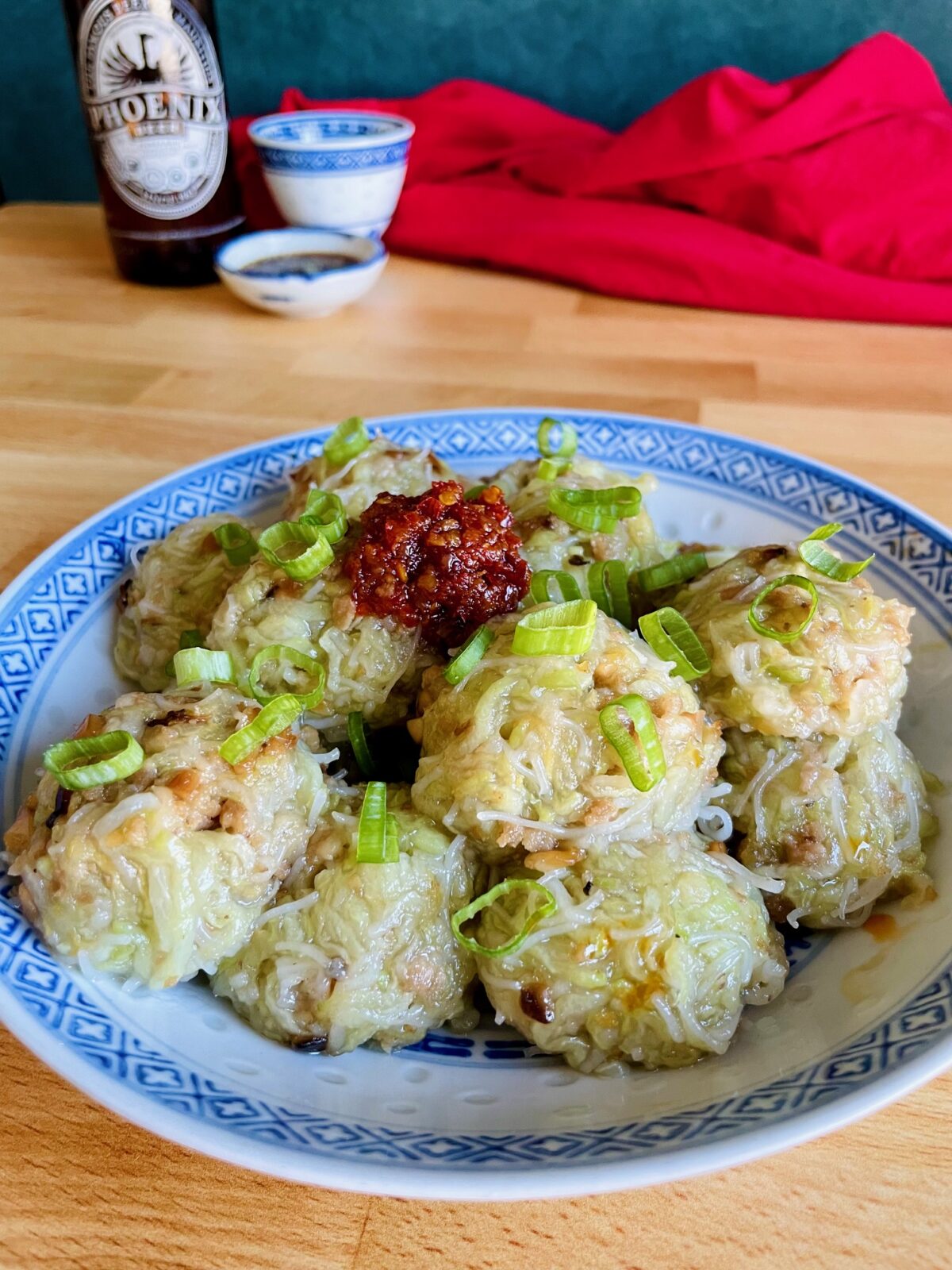
Why you’ll love this niouk yen recipe
- Healthy. This dish is primarily veggies, and it is also steamed, which is the healthiest cooking method.
- Simple Ingredients. If you have a Chinese grocery store near, you shouldn’t have any issue sourcing the ingredients for this recipe.
- Freezer-friendly. Double the batch on your second try and freeze one batch for later. These dumplings freeze very well.
- Make it vegetarian or vegan. Replace the meat and dried shrimp with 1 extra chayote and additional dried shiitake. You can omit the fish sauce or replace it with extra soy sauce to turn this dish vegan.
Recipe ingredients
You’ll need the following ingredients to make this homestyle Chinese Chayote Dumplings recipe
- 6 chayote squashes (chouchou), peeled, halved, de-seeded, and grated
- 2 teaspoons salt (to salt the grated chayote)
- 7 oz (200 grams) ground chicken
- 3 whole dried shiitake mushroom (4 tablespoons worth of minced shiitake mushroom that has been reconstituted)
- 4 teaspoons Chinese dried shrimp
- 3/4 cup tapioca flour (about 2 tablespoon per chayote)
- 1 3/4oz (50 grams) rice vermicelli
- 1 tablespoon fish sauce
- 2 teaspoons soy sauce
- 1/2 teaspoon sesame oil
- 1/2 cup vegetable oil (mostly used for frying, then discarded)
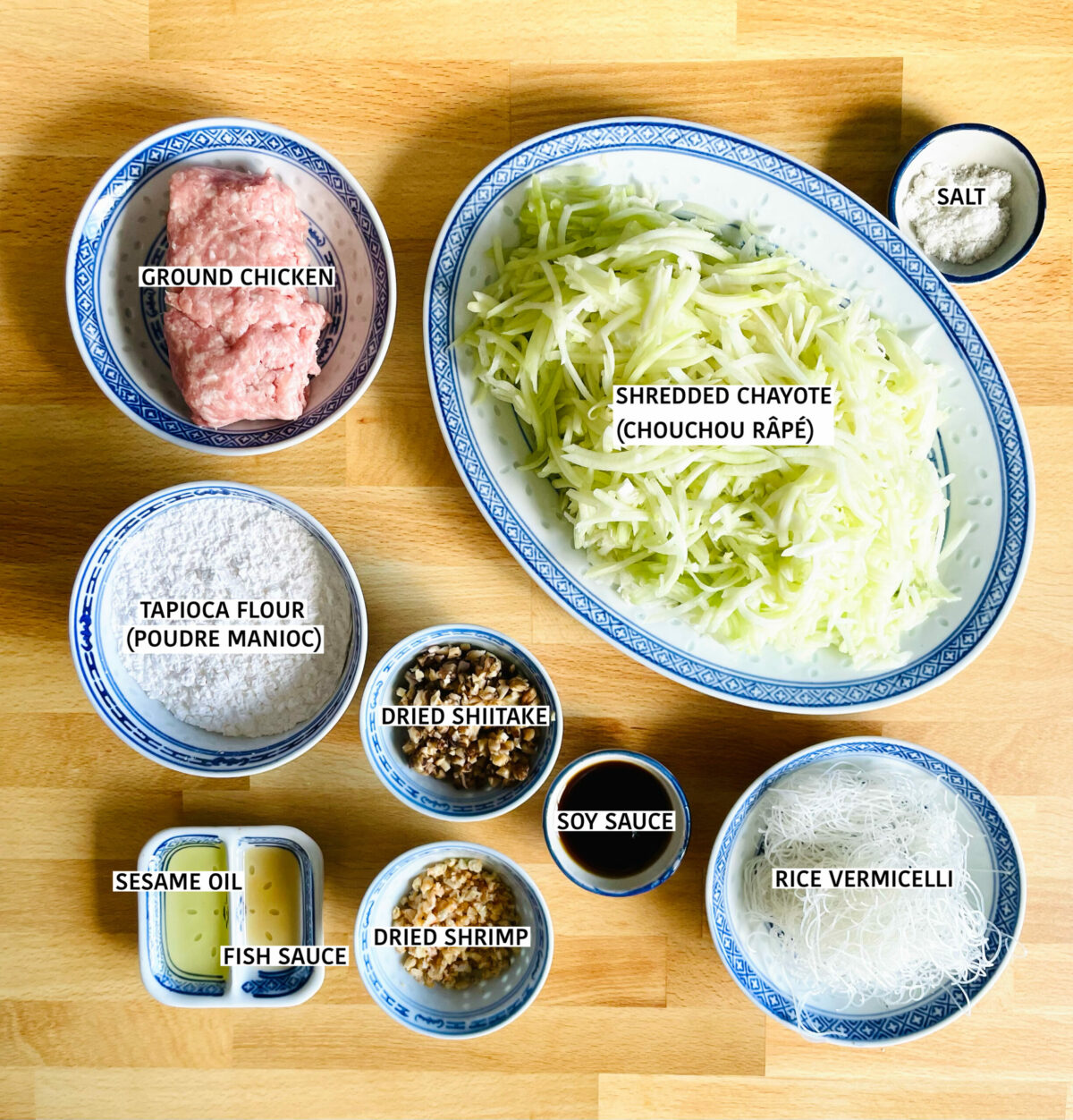
Ingredients notes
Chicken
You can substitute almost any type of meat for the chicken. The ones that will taste the best in this dish besides chicken are pork or beef. You can also omit the meat altogether and make it vegetarian or vegan.
Dried shrimp
Asian dried shrimp measure anywhere from 5mm to 10mm. You can find them at any Chinese market.
If you don’t like dried shrimp or are allergic to them, you can omit them without sacrificing too much on the final taste.
Tapioca flour
I like to use tapioca flour but you can use corn starch instead. They’re basically interchangeable in this niouk yen recipe.
Do not use regular all-purpose flour as it’s not traditional, and you’ll lose the nice bouncy feel to them.
How to make this Chinese chayote dumplings recipe step by step
Step 1
The first step is to prepare the chayote squashes. Be sure to wear gloves for this part because the chayote can release a sticky substance that is hard to remove even with soap and scrubbing, plus it can make your skin itchy!
Using a pairing knife, peel the chouchou, including all the little bits of skin in between the folds.
See the Recipe Tips and Tricks section below for extra details and accompanying pictures on how to handle the chayote squashes!
Step 2
Cut the chouchou in half, and carefully remove the flat seed. Grate the chouchou pieces into a large mixing bowl using a grater or a food processor like Cuisinart.
Step 3
Add 2 teaspoons of salt to the grated chouchou. Mix everything really well and transfer into a large strainer (or colander). Put the large strainer over a large mixing bowl to collect all the water. Set aside and let it sit for 45 minutes to 1 hour. If you only set it aside for 10-15 minutes (which is what most recipes will tell you to do), the grated chouchou will not release enough water.
Step 4
While you wait for the salt and grated chayote to do their thing, reconstitute the dried shiitake mushroom and dried shrimp in a bowl by adding enough warm water to cover them by an inch.
They’ll take about 15-20 minutes to soften. Once they are soft enough to cut, mince them and set this shiitake and dried shrimp mixture aside.
Step 5
Heat 1/2 cup of vegetable oil in a wok or large deep pan over medium heat.
When the wok is hot, add the rice vermicelli. This step takes just a few seconds. Once you add the rice vermicelli, it’ll expand quickly in the hot oil. Remove it immediately and set aside this fried rice vermicelli to drain in a strainer or on paper towels.
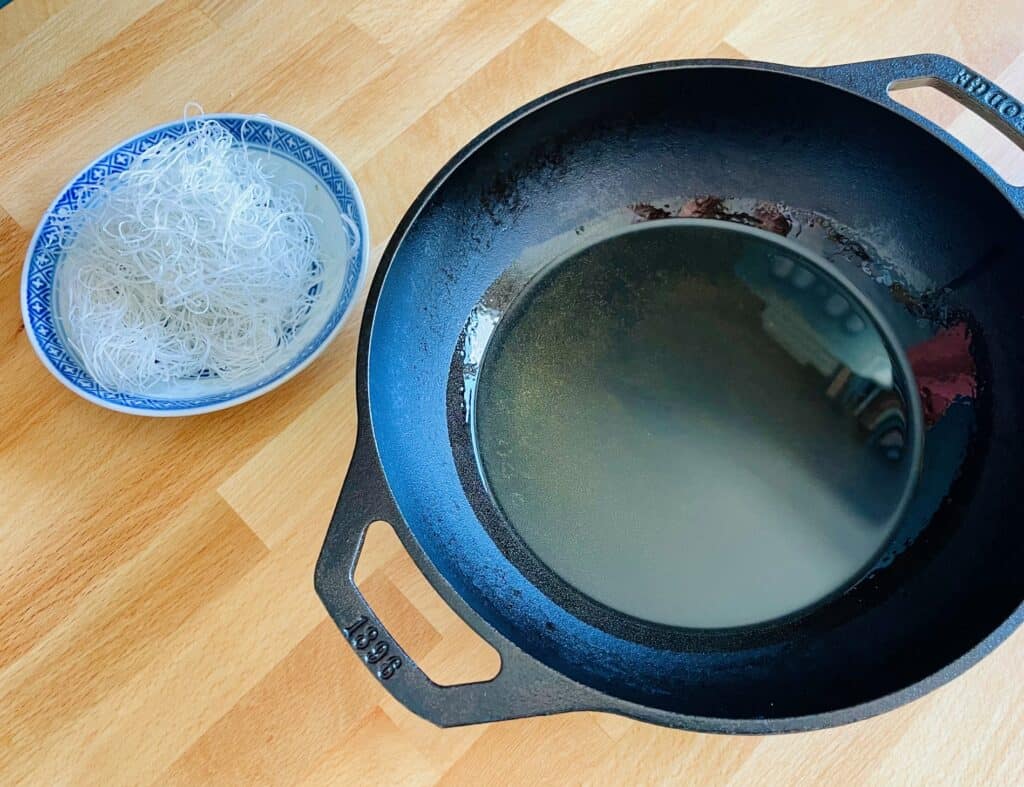
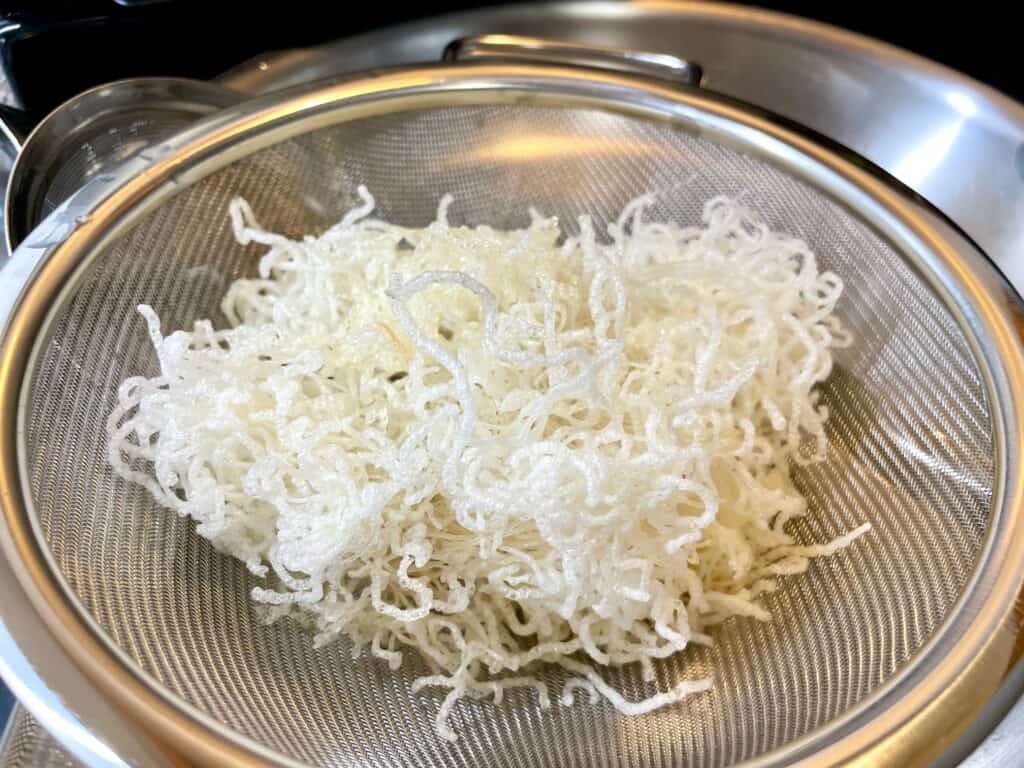
Step 6
Carefully remove all but 2 tablespoons of oil from the wok. Heat the oil again on medium heat and add the shiitake and dried shrimp mixture.
Cook until they turn slightly golden. At this stage, add the chicken and cook while continuously breaking down the ground chicken into smaller pieces. When the chicken is almost cooked, add the fish sauce and the soy sauce until chicken is completely cooked. Set this chicken mixture aside.
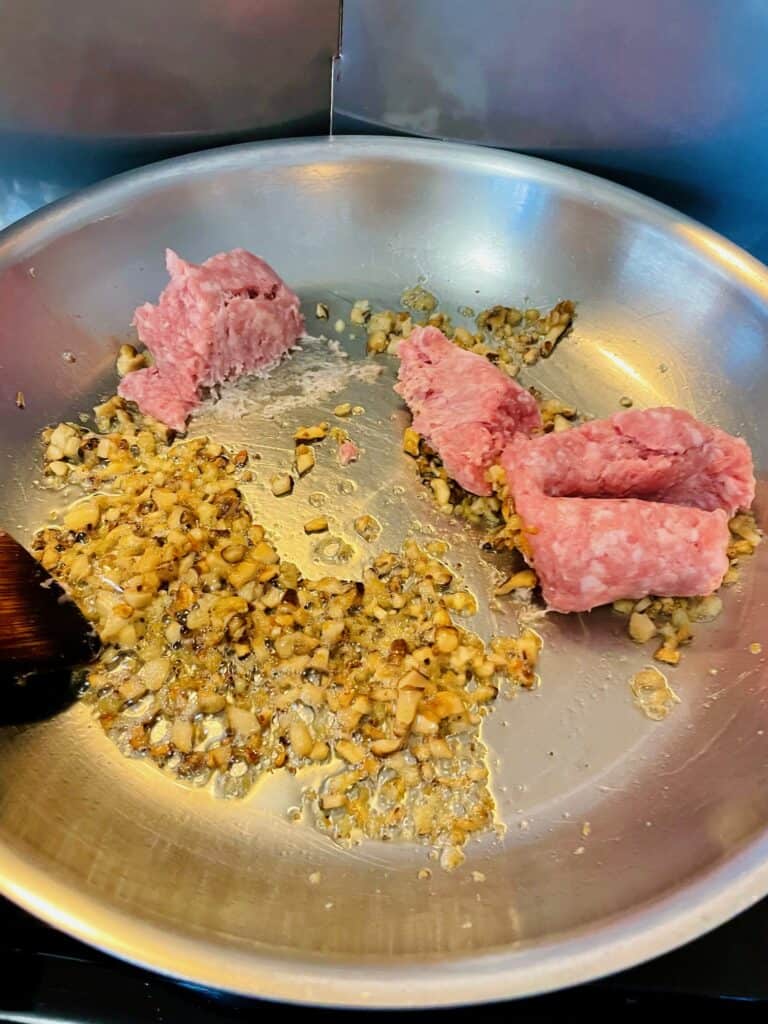
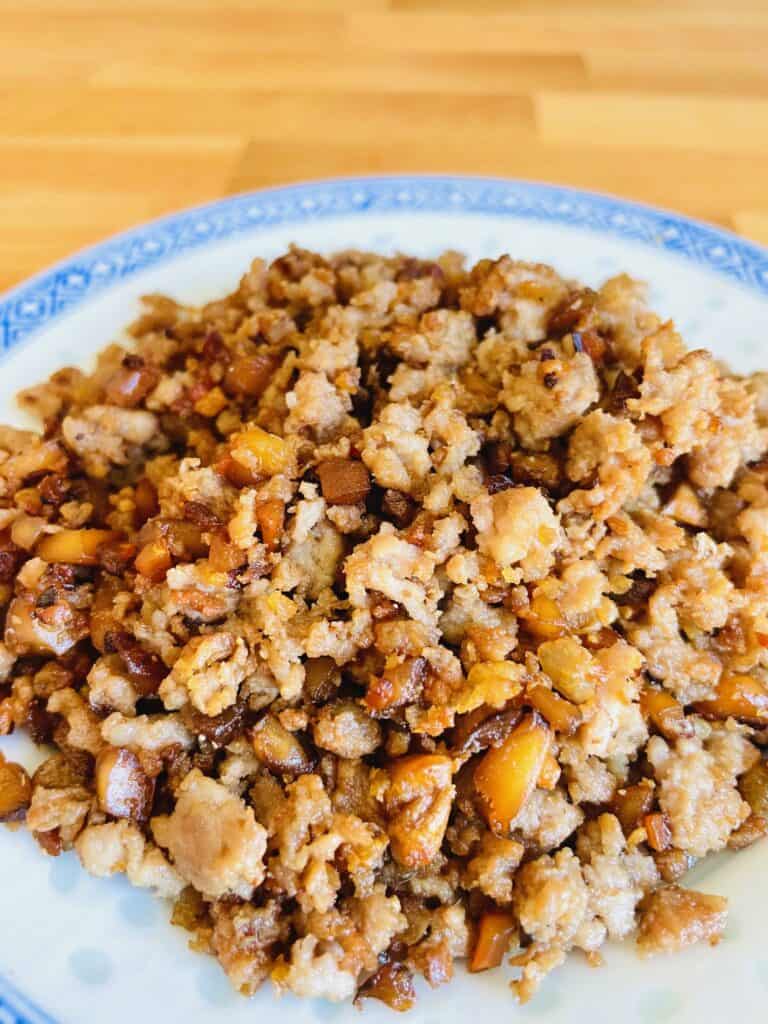
Step 7
After 45 minutes to 1 hour, wear a fresh pair of gloves and squeeze out all the excess water from the grated chouchou by hand.
If you have a large tea towel, even better! Use it to squeeze out even more water from the squash. Transfer the grated chayote into the tea towel and squeeze out as much water as you can. Set aside.
Step 8
Add 3 inches of water in a large steamer and heat it on medium high heat. While this is heating up, you can proceed to the next step.
Step 9
In a large mixing bowl, add the grated chayote, chicken mixture, fried rice vermicelli, tapioca starch, and sesame oil. Mix well and form into balls the size of golf balls.
Note: The chayote dumplings should have a sticky consistency and mostly hold their shape. It’s okay if they fall apart a little as long as they keep their shape for the most part. The steaming process will seal the dumpling together nice and tight!
If they’re falling apart a bit too much, add 1-2 teaspoons of extra tapioca flour. You can add up to 3 teaspoons, not much more because you’ll change the consistency of the dumplings.
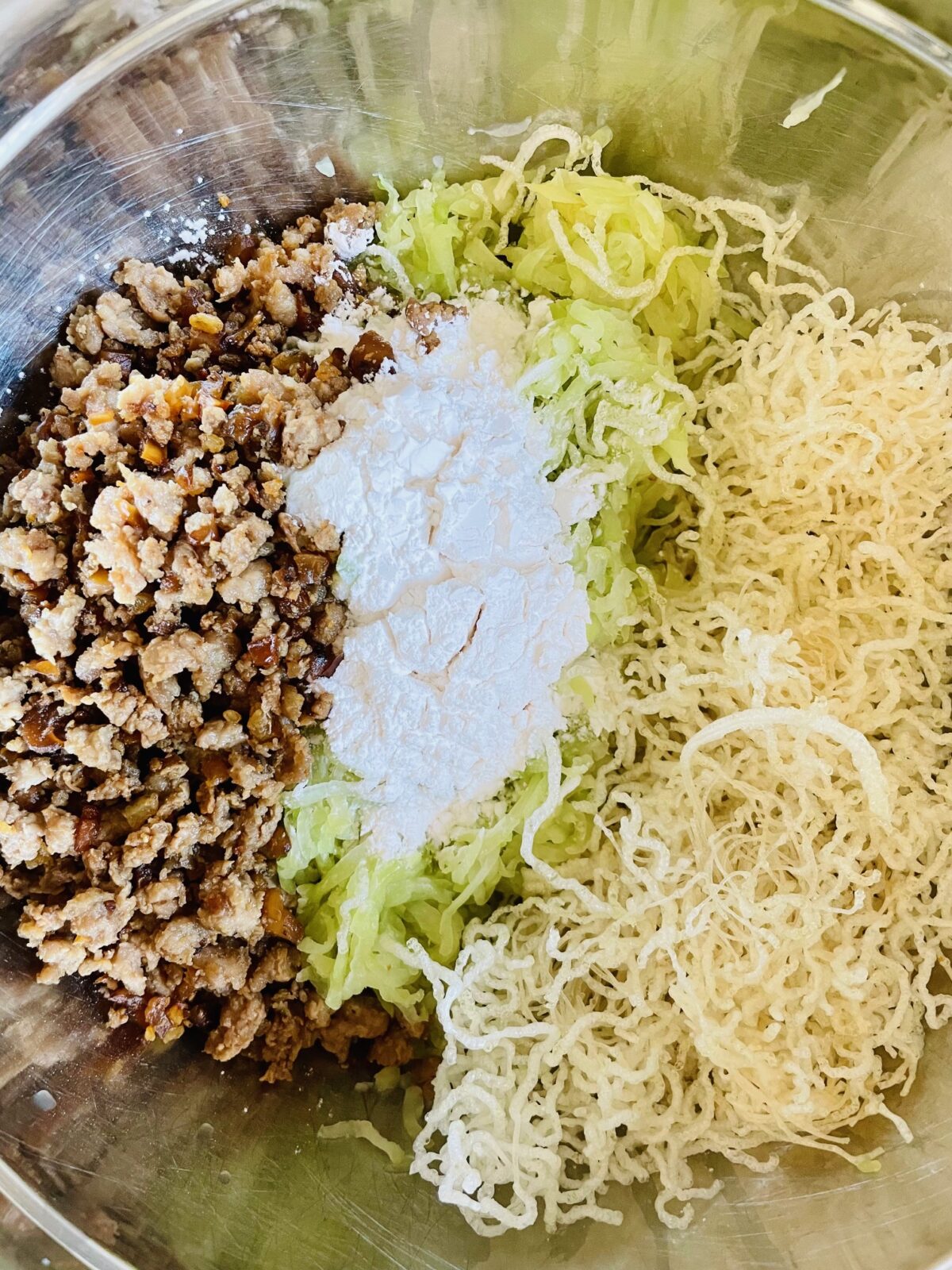
Step 10
By now, the water in your steamer should be gently boiling and ready. Spray the steamer tray with a little bit of oil and add the uncooked chayote dumpling to it, making sure to leave a little bit of space in between them.
Leave just enough to let the steam circulate so that the dumplings cook evenly, about half centimeter in between them should be enough.
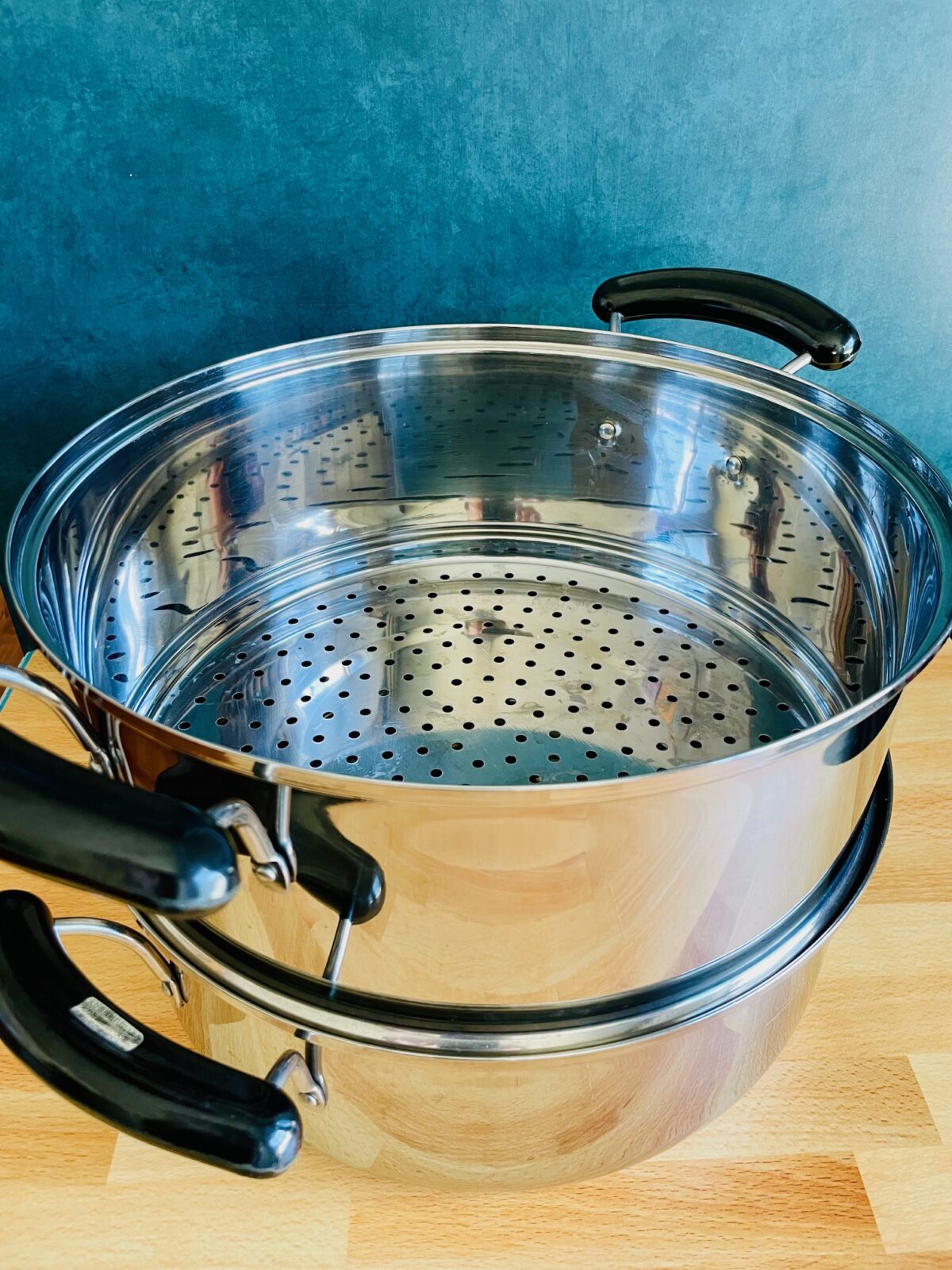
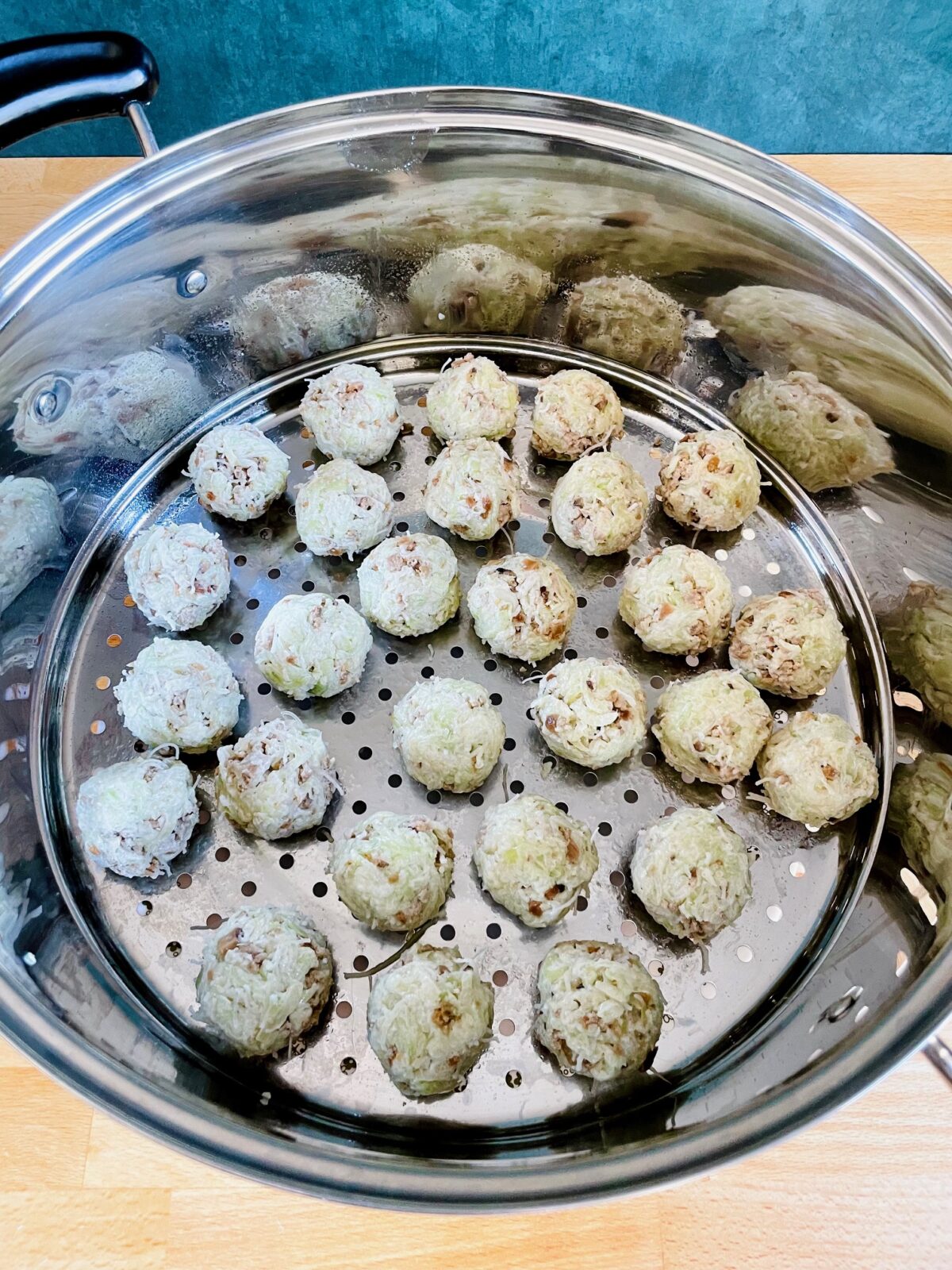
Step 11
Steam on medium high heat for 20 minutes.
This dish is best eaten fresh. Serve immediately with some chopped green onion and Chinese Red Chili Paste.
How to prepare the chayote
Select the nice ones
Carefully choose chayote squashes without too many brown spots on the skin. It’s normal for chayote to have a few, but too many brown spots means they’re older and not as fresh.
Pick the younger and tender chayote squashes that are smaller in size.
Peeling
Chayote squashes release a sticky substance that you probably wouldn’t want on your hands because they’re hard to scrub off and they can make the skin itchy.
Wear gloves to peel and grate the chouchou!
De-seeding and grating
Use a pairing knife to remove the seed. Grate the chouchou by hand or by using a handy dandy food processor! I use a Cuisinart food processor, which makes my life so much easier. I started making more boulette chouchou once I owned one, it’s that great at its job!
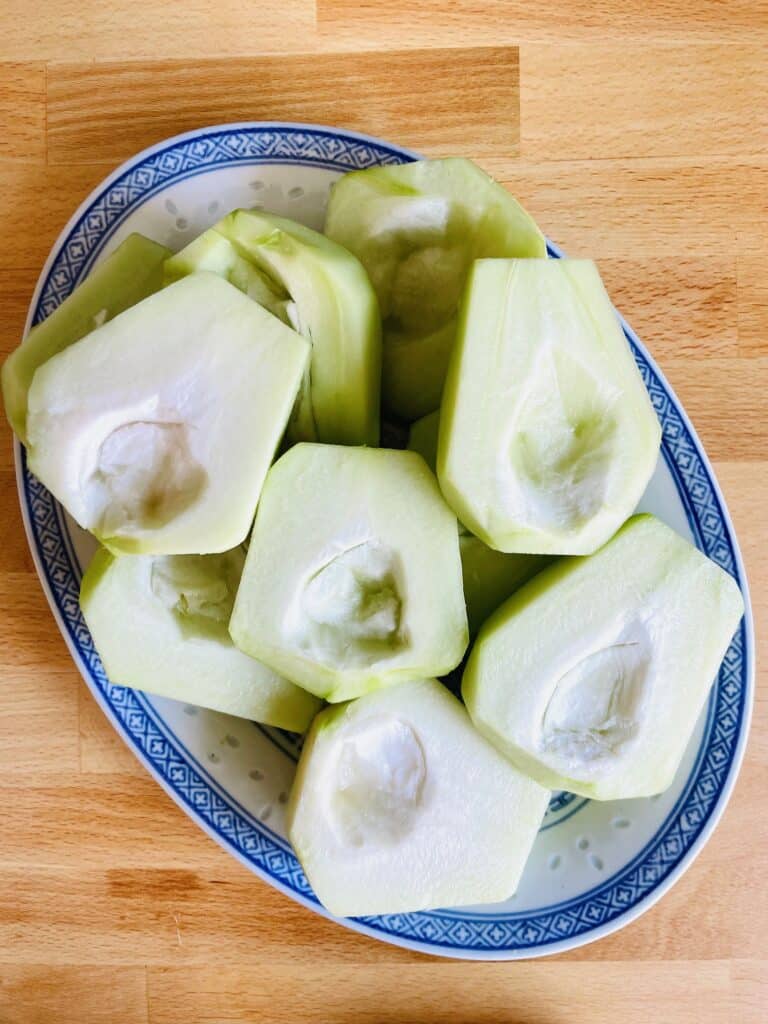
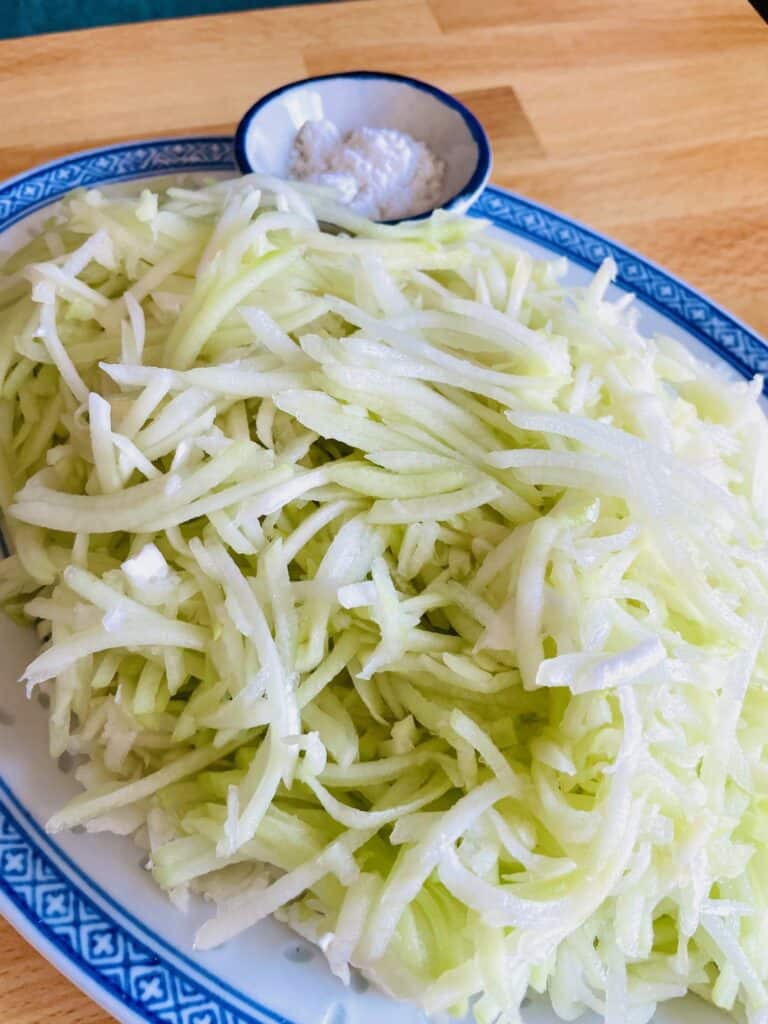
Salting and removing excess water – important step
My method for salting and removing excess water will result in a non-soggy niouk yen mixture ready to be mixed with the right amount of tapioca flour before steaming.
A soggy niouk yen mixture would require additional tapioca flour to hold its shape and your final result would be almost chewy and gummy due to the extra starch. You don’t want that.
This is a common mistake for first-timers. To be rewarded with the most perfect boulette chouchou follow the directions closely!
Add 2 teaspoons of salt to your grated chouchou. Mix everything really well and transfer into a large strainer (or colander). Put the large strainer over a large mixing bowl to collect all the water.
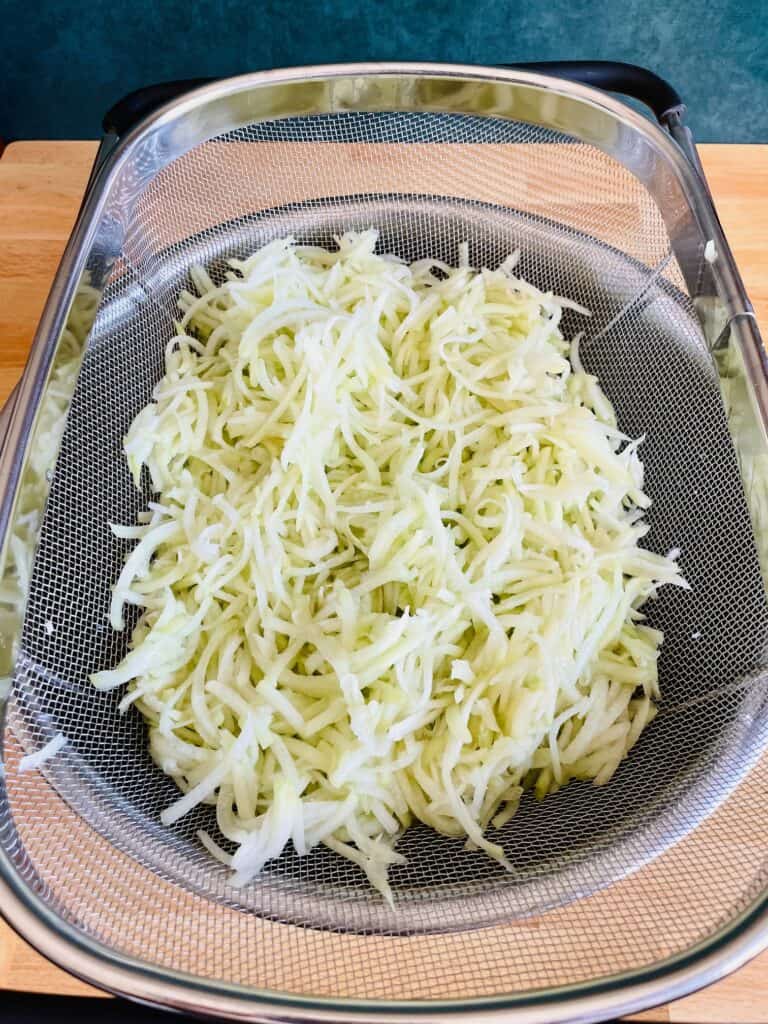
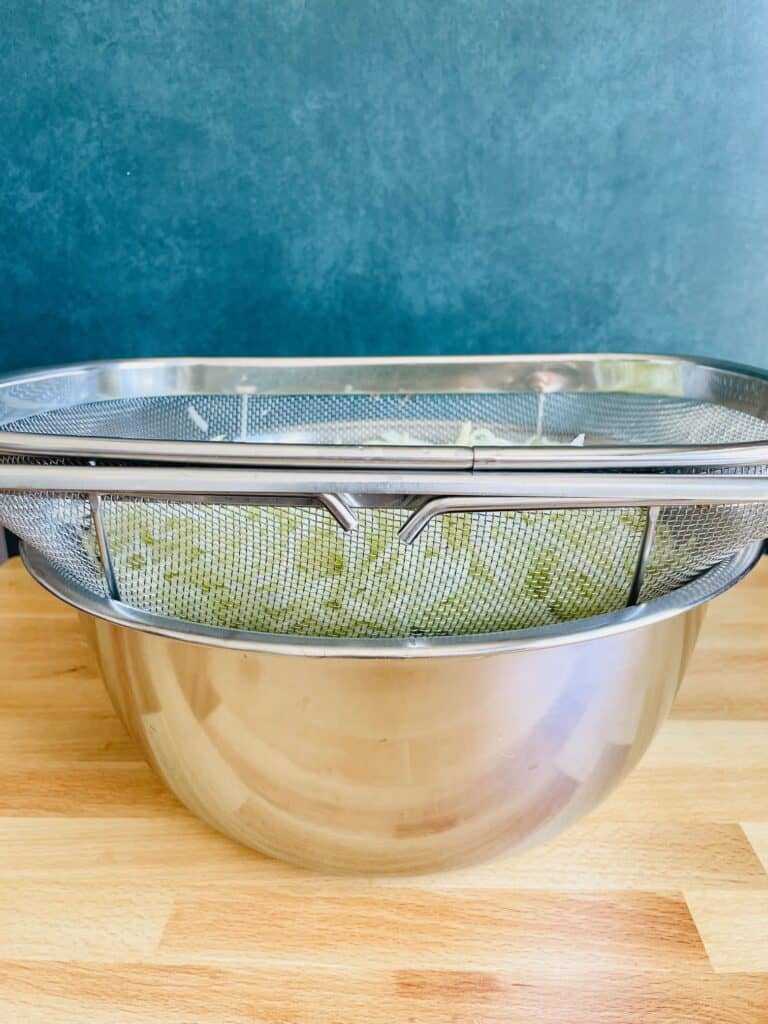
Let the water drip for 45 minutes to 1 hour. This step is important (and it’s my secret tip!) because you’ll give enough time for the salt to draw all the excess moisture from the shredded chayote.
Squeeze out all the excess water by hand or using a large tea towel.
Sourcing chayote squash for Boulette Chouchou
Depending on where you’re located in the world, you might find all the necessary ingredients, including chayote squash, at your local grocery stores or bazaar. However, if you’re in a country where chayote is uncommon, you will find it at any Asian market.
Storage and freezing
Let the boulettes chouchou cool down completely so they don’t trap moisture. Transfer the boulettes to an airtight container and keep in the fridge for 4 days. They freeze well and keep for about 6 months in the freezer.
Frequently Asked Questions (FAQs)
A large steamer or any type of steamer or makeshift steamer will work well to cook the boulette chouchou.
A food processor like Cuisinart is also very helpful to effortlessly grate the chayote.
It is relatively easy to make. Your first time might be a bit tricky because there are many steps to this recipe. This is why I added a lot of pictures to help guide you through each one.
If you follow all the steps and consult the pictures, you’ll have a successful dish. Please leave me a comment below if you have any questions!
This dish is not spicy but it is often served with an optional red chili paste, which is spicy. You can omit the red chili paste or use less, per your liking.
What should I serve with Mauritian boulette chouchou
Niouk yens can be enjoyed on their own with just some chili sauce and chopped green onion or along with other types of boulettes like sao mai, teokon, or boulette poisson.
It is also served as a side dish for other Mauritian Hakka dishes like fried noodles, fried rice, or soups.

Chinese Chayote Squash Dumplings Recipe (Boulette Chouchou)
Equipment
- 1 Large steamer or any makeshift steamer
- 1 food processor like Cuisinart or a grater
Ingredients
Chayote preparation
- 6 chayote squashes (chouchou)
- 2 teaspoons salt
The rest
- ½ cup vegetable oil I used avocado oil
- 1¾ ounces rice vermicelli 50 grams (or 1 large handful)
- 3 whole dried shiitake mushrooms 4 tablespoons worth of minced shiitake mushroom that has been reconstituted
- 2 tablespoons Asian dried shrimp
- 7 ounces ground chicken 200 grams
- 1 tablespoon fish sauce
- 2 teaspoons soy sauce
- ¾ cup tapioca flour/starch la poudre manioc
- ½ teaspoon sesame oil
Instructions
Prepare the chayote
- Be sure to wear gloves for this part because the chayote can release a sticky substance that is hard to remove even with soap and scrubbing, plus it can make your skin itchy!
- Using a pairing knife, peel the chouchou, including all the little bits of skin in between the folds.
- Cut the chouchou in half, and carefully remove the flat seed. Grate the chouchou pieces into a large mixing bowl using a grater or a food processor like Cuisinart.
- Add 2 teaspoons of salt to the grated chouchou. Mix everything really well and transfer into a large strainer (or colander). Put the large strainer over a large mixing bowl to collect all the water.
- Set aside and let it sit for 45 minutes to 1 hour. If you only set it aside for 10-15 minutes (which is what most recipes will tell you to do), the grated chouchou will not release enough water.
Prepare the dried shiitake and dried shrimp
- While you wait for the salt and grated chayote to do their thing, reconstitute the dried shiitake mushroom and dried shrimp in a bowl by adding enough warm water to cover them by an inch.
- They'll take about 15-20 minutes to soften. Once they are soft enough to cut, mince them and set this shiitake and dried shrimp mixture aside.
Fry the rice vermicelli
- Heat 1/2 cup of vegetable oil in a wok or large deep pan over medium heat. When the wok is hot, add the rice vermicelli. This step takes just a few seconds.
- Once you add the rice vermicelli, it'll expand quickly in the hot oil. Remove it immediately and set aside this fried rice vermicelli to drain in a strainer or on paper towels.
Cook the dried shiitake, dried shrimp, and chicken
- Carefully remove all but 2 tablespoons of oil from the wok. Heat the oil again on medium heat and add the shiitake and dried shrimp mixture. Cook until they turn slightly golden.
- At this stage, add the chicken and cook while continuously breaking down the ground chicken into smaller pieces. This will take about 12 minutes.
- When the chicken is almost cooked, add the fish sauce and the soy sauce until chicken is completely cooked. Set this chicken mixture aside.
Squeeze the water content from the chayote
- After 45 minutes to 1 hour, squeeze out all the excess water from the grated chouchou by hand.
- If you have a large tea towel, even better! Use it to squeeze out even more water from the squash. Transfer the grated chayote into the tea towel and squeeze out as much water as you can. Set aside.
- Add 3 inches of water in a large steamer and heat it on medium high heat. While this is heating up, you can proceed to the next step.
Roll the dumpling balls
- In a large mixing bowl, add the grated chayote, chicken mixture, fried rice vermicelli, tapioca starch, and sesame oil.
- Mix well and form into golf-sized balls. See NOTES section for more info.
Cook the dumplings
- By now, the water in your steamer should be gently boiling and ready. Spray the steamer tray with a little bit of oil and add the uncooked chayote dumpling to it, making sure to leave a little bit of space in between them. Leave just enough space to let the steam circulate so that the dumplings cook evenly, about half centimeter in between them should be enough.
- Steam on medium high heat for 20 minutes.
- These Chinese chayote dumplings are best eaten fresh. Top with chopped green onion and serve immediately with a hot chili sauce like my Chinese Red Chili Paste. Enjoy!
Notes
I hope you enjoyed this recipe and please leave me comment if you have any questions! I would love to hear from you.
This boulette chouchou is featured in my list of 27 Typical Mauritian Street Food you shouldn’t miss on your visit to Mauritius. Check out for yourself what other yummy treats I put together!


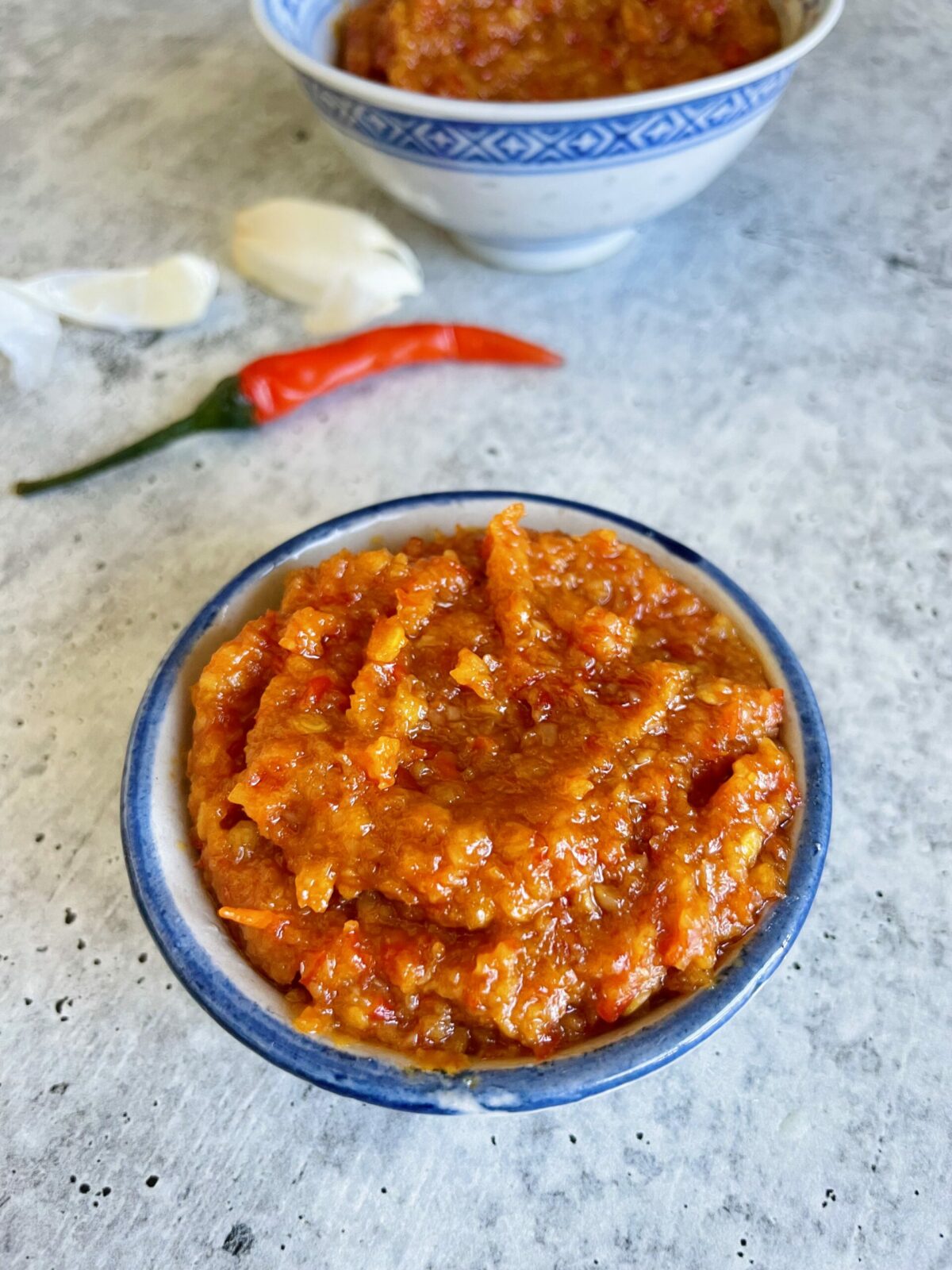
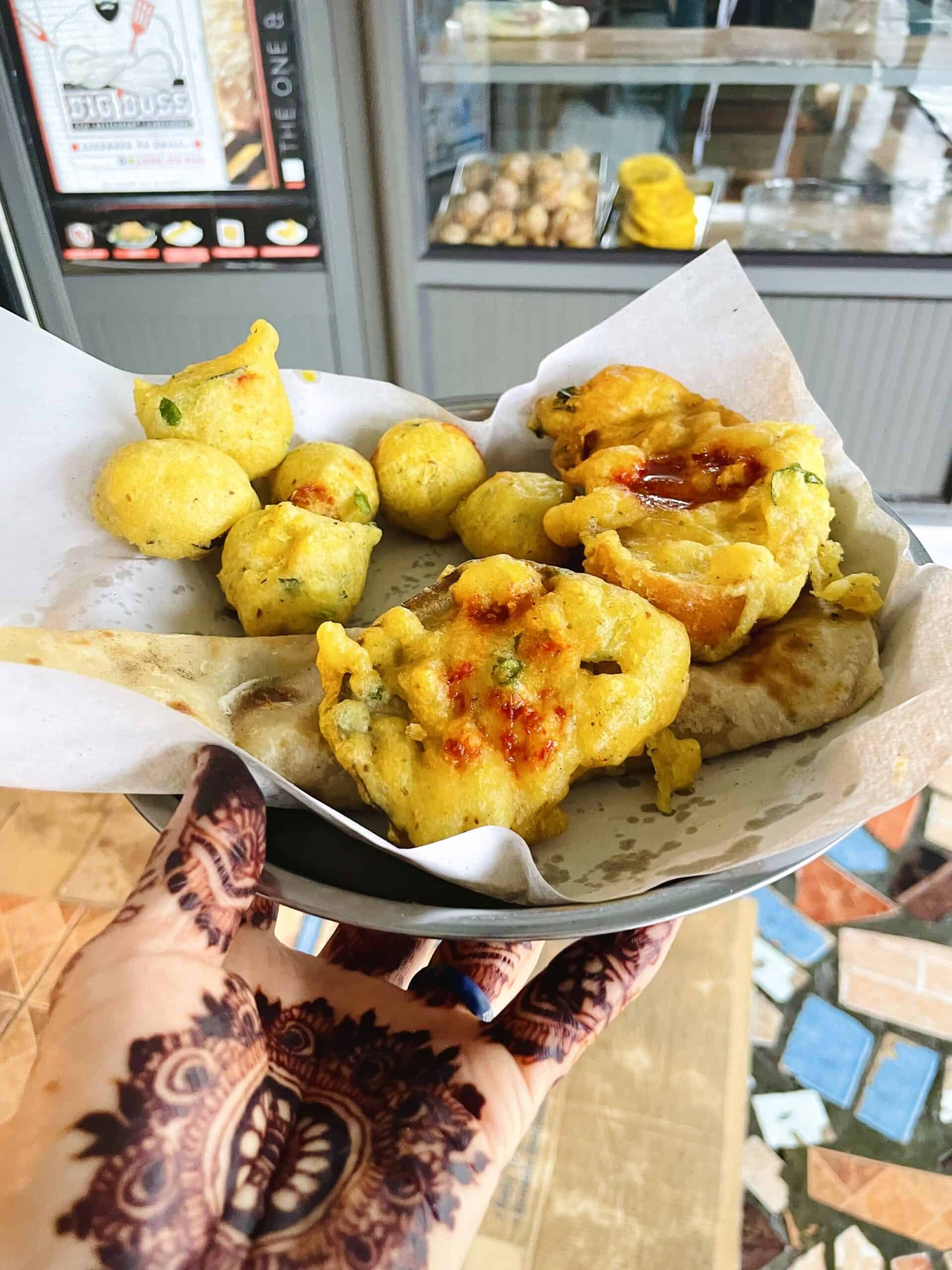
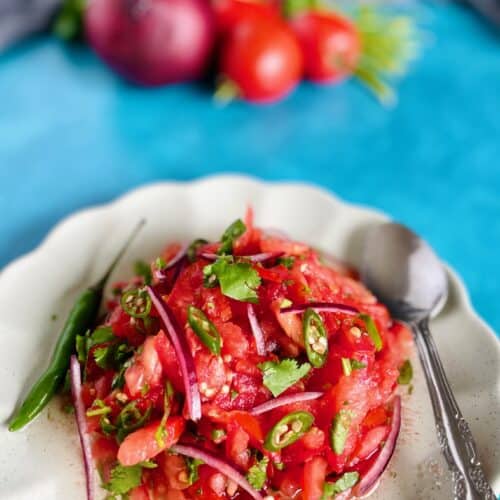

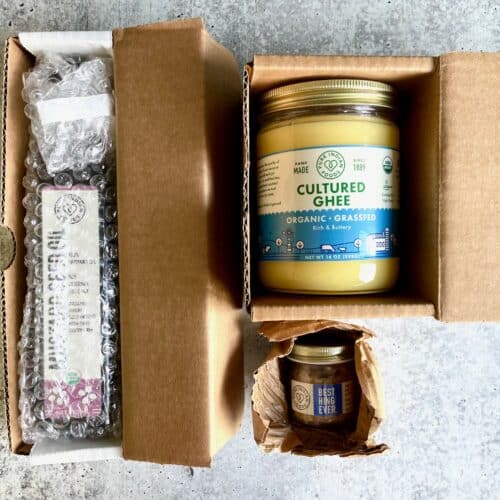

Leave a Reply